ARTH 399 Alternative Media Syllabus (PDF)
File information
This PDF 1.5 document has been generated by pdfsam-console (Ver. 2.4.1e) / iText 2.1.7 by 1T3XT, and has been sent on pdf-archive.com on 09/10/2014 at 06:31, from IP address 206.209.x.x.
The current document download page has been viewed 880 times.
File size: 463.51 KB (16 pages).
Privacy: public file
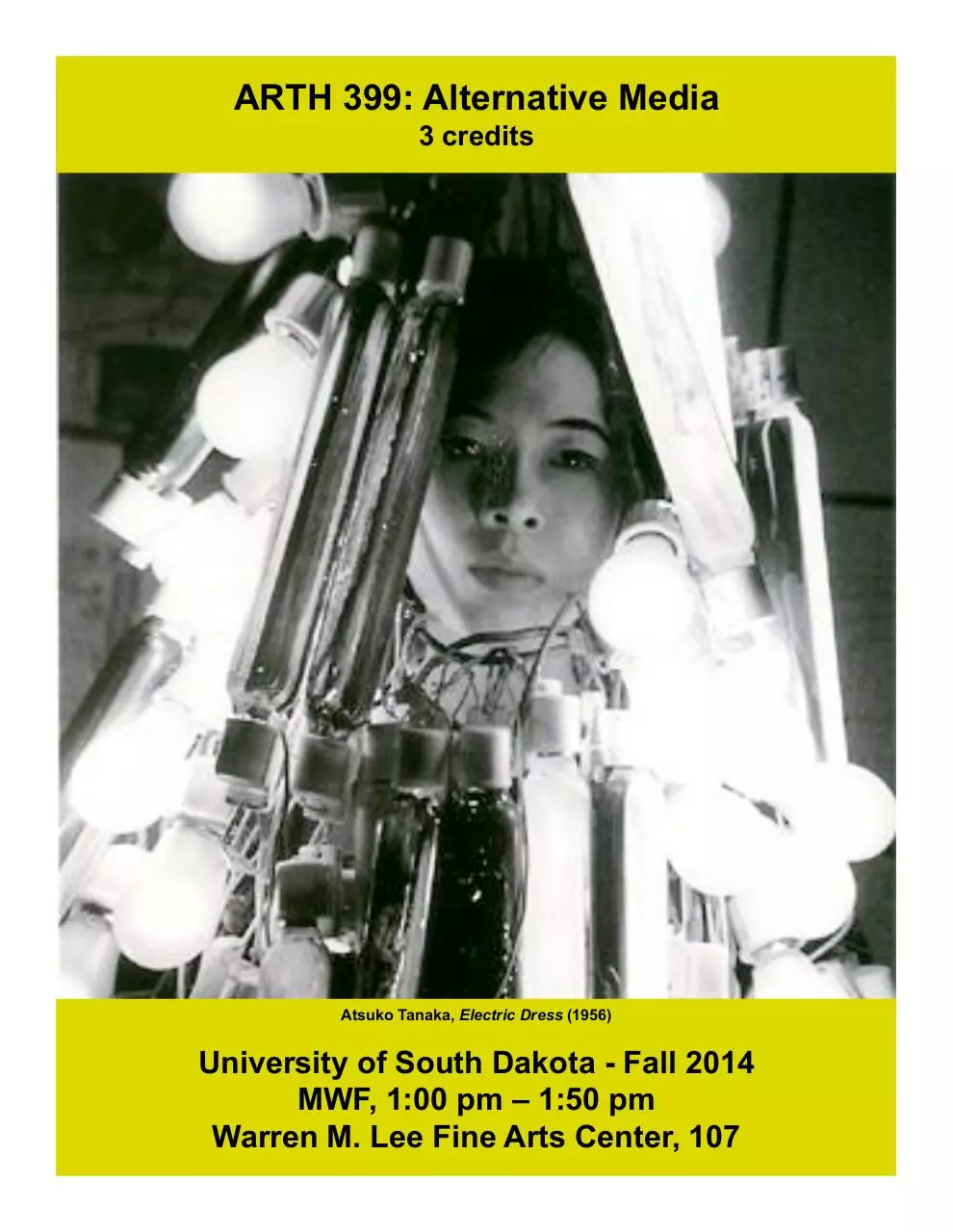
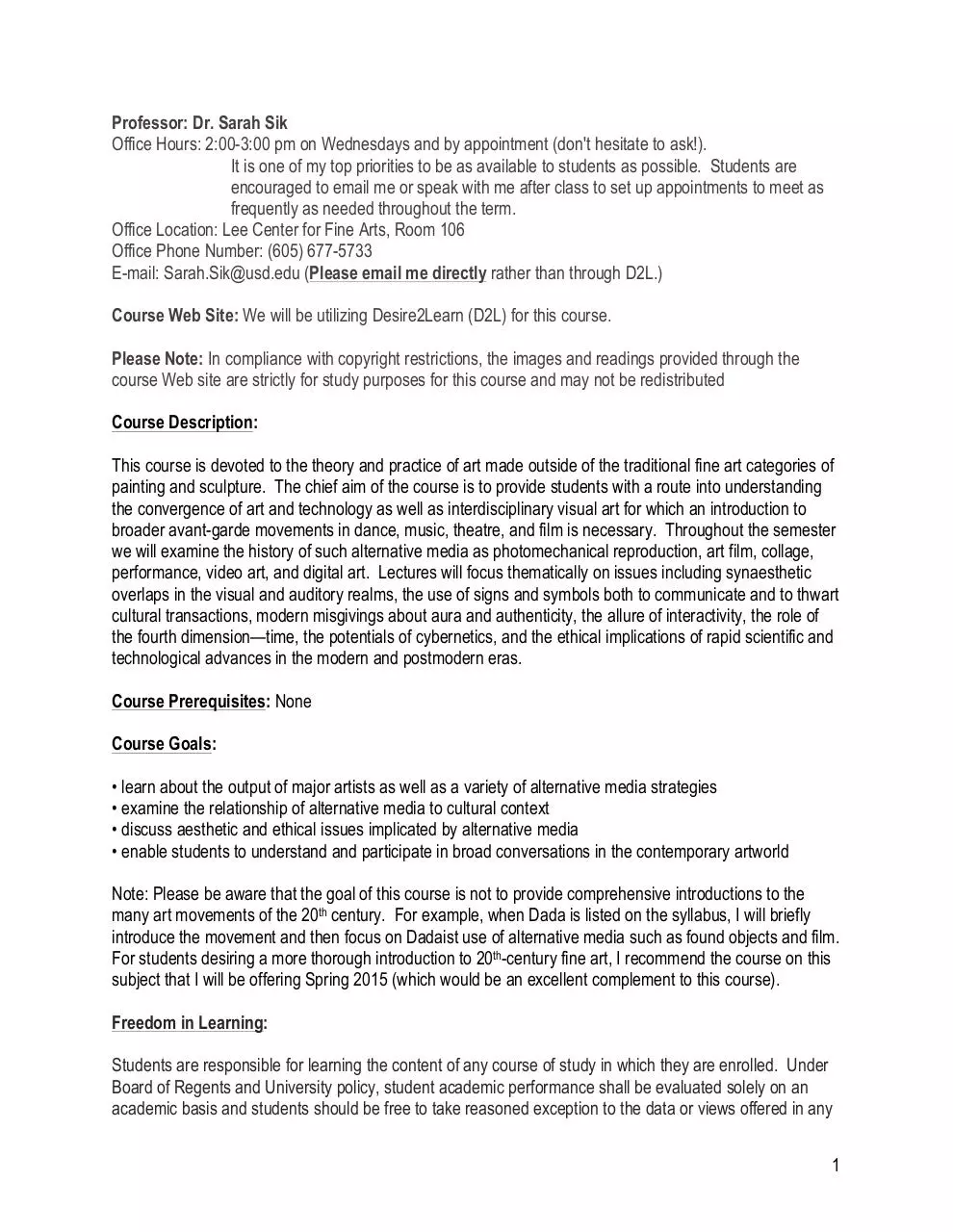
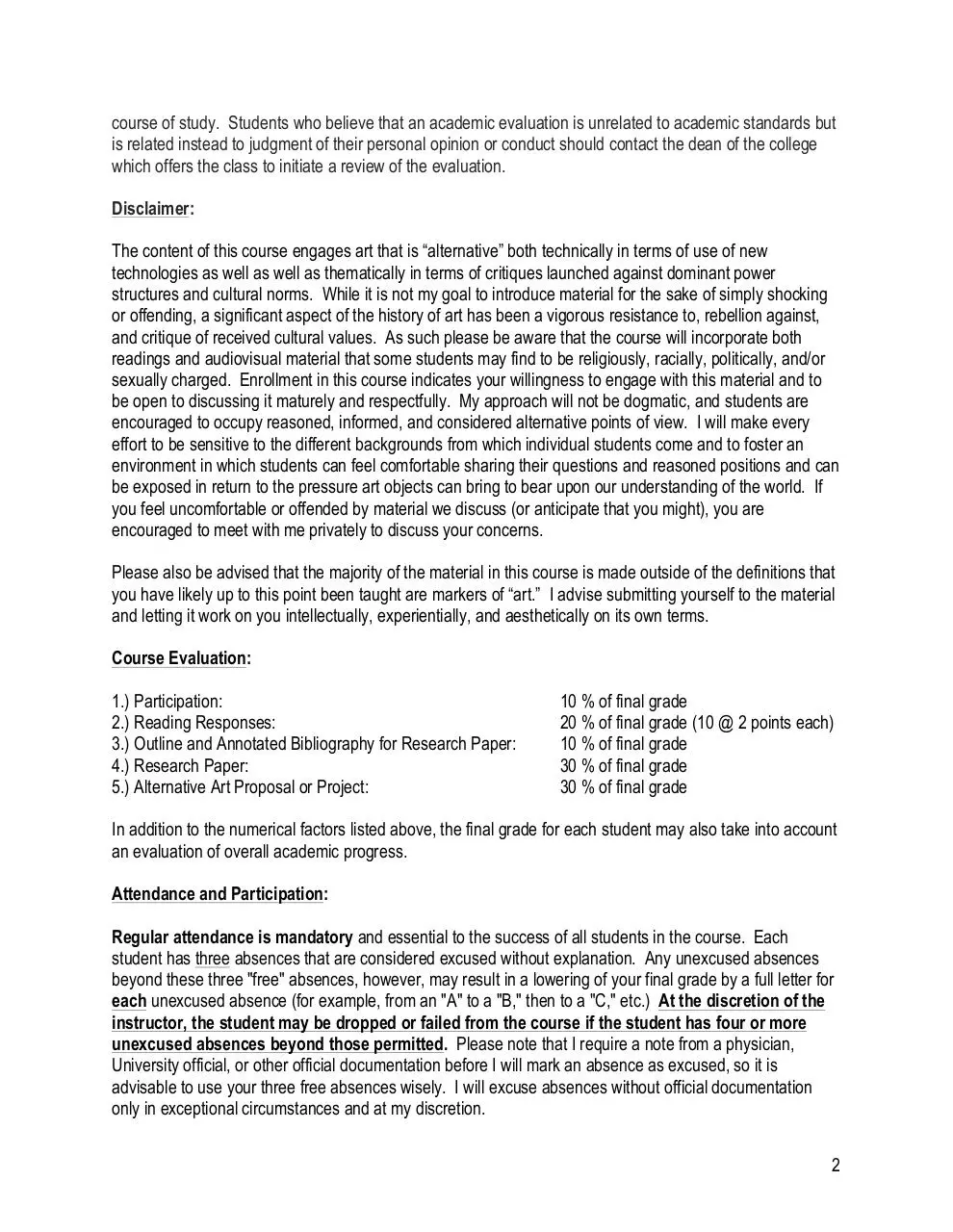
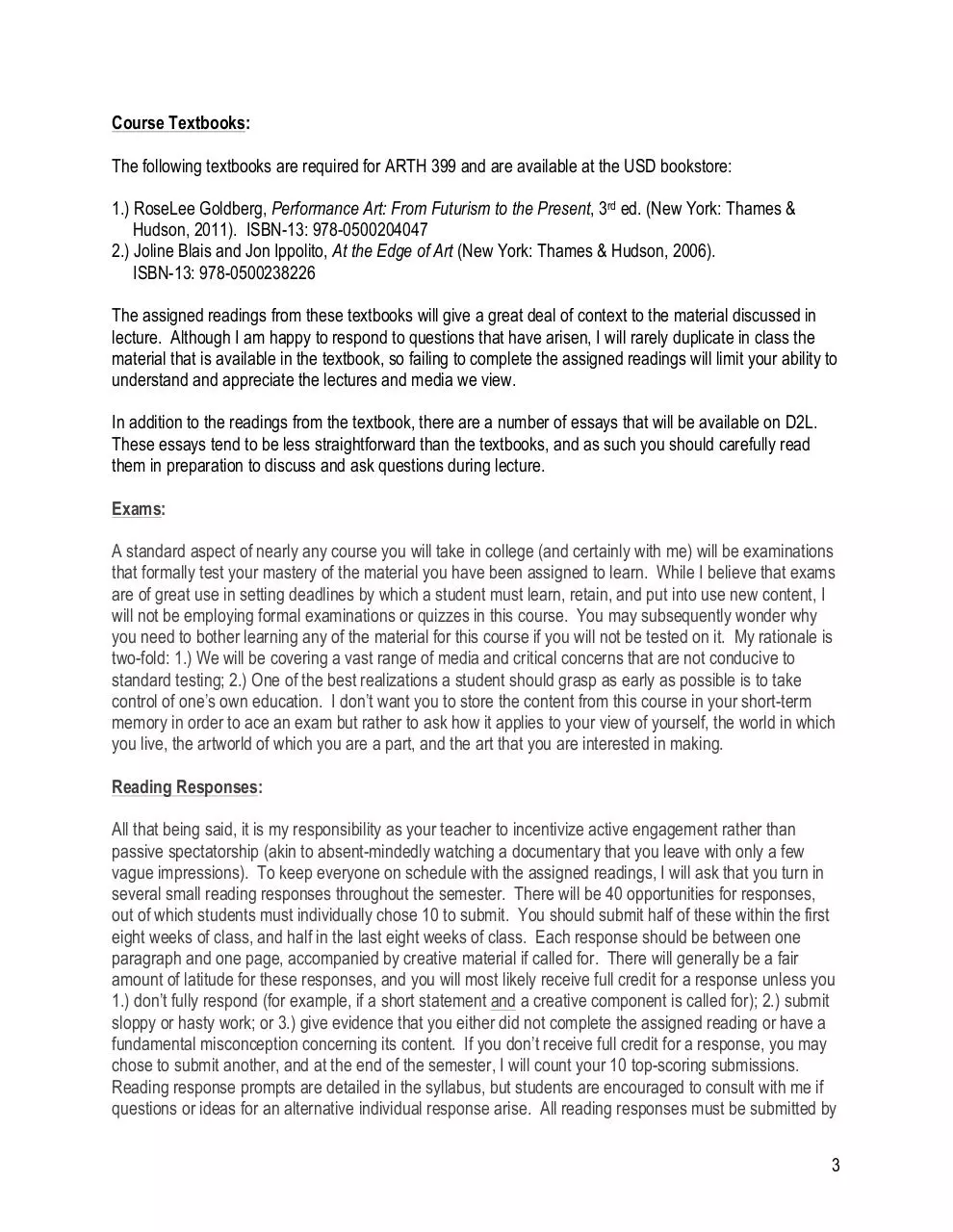
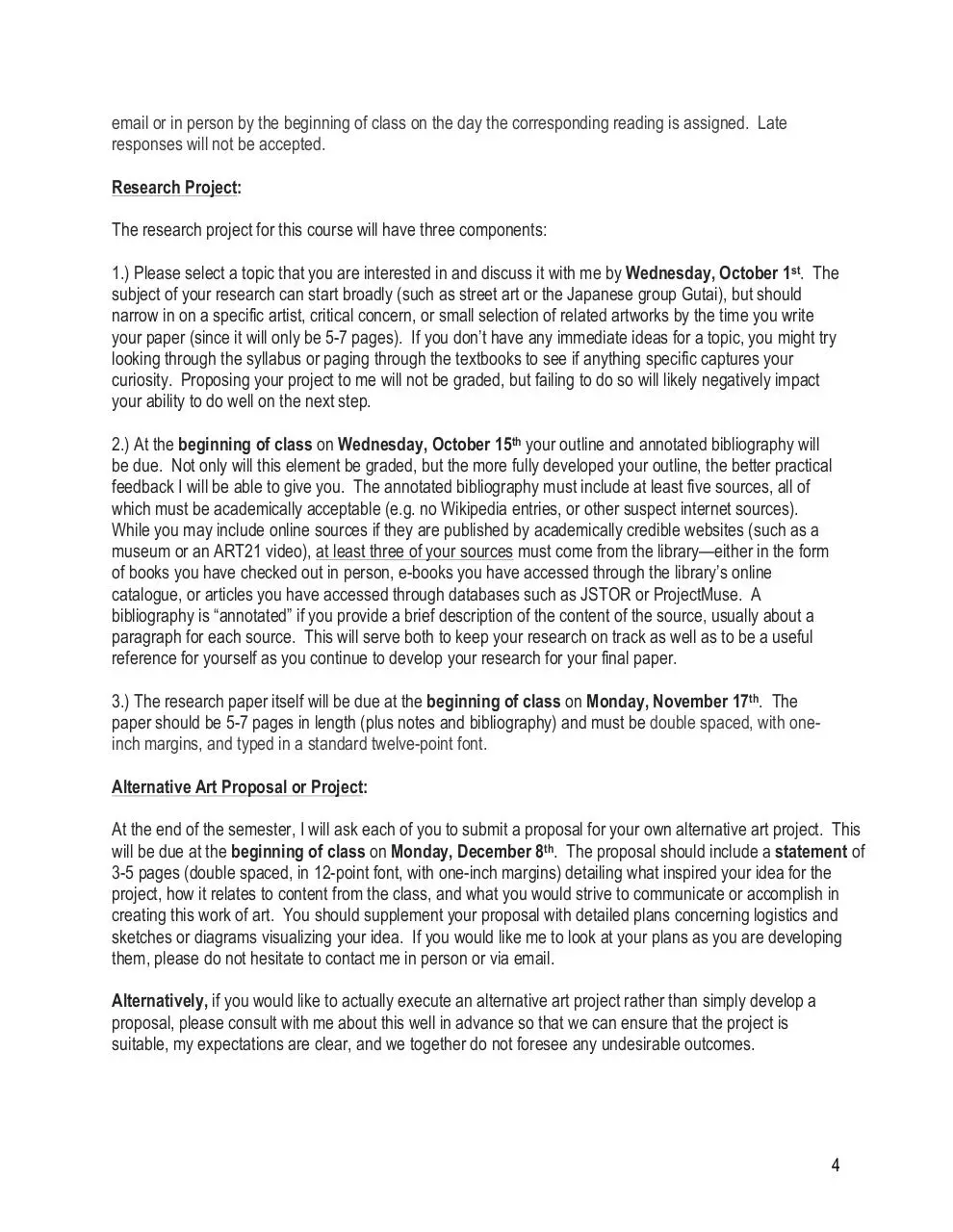
File preview
ARTH 399: Alternative Media
3 credits
Atsuko Tanaka, Electric Dress (1956)
University of South Dakota - Fall 2014
MWF, 1:00 pm – 1:50 pm
Warren M. Lee Fine Arts Center, 107
Professor: Dr. Sarah Sik
Office Hours: 2:00-3:00 pm on Wednesdays and by appointment (don't hesitate to ask!).
It is one of my top priorities to be as available to students as possible. Students are
encouraged to email me or speak with me after class to set up appointments to meet as
frequently as needed throughout the term.
Office Location: Lee Center for Fine Arts, Room 106
Office Phone Number: (605) 677-5733
E-mail: Sarah.Sik@usd.edu (Please email me directly rather than through D2L.)
Course Web Site: We will be utilizing Desire2Learn (D2L) for this course.
Please Note: In compliance with copyright restrictions, the images and readings provided through the
course Web site are strictly for study purposes for this course and may not be redistributed
Course Description:
This course is devoted to the theory and practice of art made outside of the traditional fine art categories of
painting and sculpture. The chief aim of the course is to provide students with a route into understanding
the convergence of art and technology as well as interdisciplinary visual art for which an introduction to
broader avant-garde movements in dance, music, theatre, and film is necessary. Throughout the semester
we will examine the history of such alternative media as photomechanical reproduction, art film, collage,
performance, video art, and digital art. Lectures will focus thematically on issues including synaesthetic
overlaps in the visual and auditory realms, the use of signs and symbols both to communicate and to thwart
cultural transactions, modern misgivings about aura and authenticity, the allure of interactivity, the role of
the fourth dimension—time, the potentials of cybernetics, and the ethical implications of rapid scientific and
technological advances in the modern and postmodern eras.
Course Prerequisites: None
Course Goals:
• learn about the output of major artists as well as a variety of alternative media strategies
• examine the relationship of alternative media to cultural context
• discuss aesthetic and ethical issues implicated by alternative media
• enable students to understand and participate in broad conversations in the contemporary artworld
Note: Please be aware that the goal of this course is not to provide comprehensive introductions to the
many art movements of the 20th century. For example, when Dada is listed on the syllabus, I will briefly
introduce the movement and then focus on Dadaist use of alternative media such as found objects and film.
For students desiring a more thorough introduction to 20th-century fine art, I recommend the course on this
subject that I will be offering Spring 2015 (which would be an excellent complement to this course).
Freedom in Learning:
Students are responsible for learning the content of any course of study in which they are enrolled. Under
Board of Regents and University policy, student academic performance shall be evaluated solely on an
academic basis and students should be free to take reasoned exception to the data or views offered in any
1
course of study. Students who believe that an academic evaluation is unrelated to academic standards but
is related instead to judgment of their personal opinion or conduct should contact the dean of the college
which offers the class to initiate a review of the evaluation.
Disclaimer:
The content of this course engages art that is “alternative” both technically in terms of use of new
technologies as well as well as thematically in terms of critiques launched against dominant power
structures and cultural norms. While it is not my goal to introduce material for the sake of simply shocking
or offending, a significant aspect of the history of art has been a vigorous resistance to, rebellion against,
and critique of received cultural values. As such please be aware that the course will incorporate both
readings and audiovisual material that some students may find to be religiously, racially, politically, and/or
sexually charged. Enrollment in this course indicates your willingness to engage with this material and to
be open to discussing it maturely and respectfully. My approach will not be dogmatic, and students are
encouraged to occupy reasoned, informed, and considered alternative points of view. I will make every
effort to be sensitive to the different backgrounds from which individual students come and to foster an
environment in which students can feel comfortable sharing their questions and reasoned positions and can
be exposed in return to the pressure art objects can bring to bear upon our understanding of the world. If
you feel uncomfortable or offended by material we discuss (or anticipate that you might), you are
encouraged to meet with me privately to discuss your concerns.
Please also be advised that the majority of the material in this course is made outside of the definitions that
you have likely up to this point been taught are markers of “art.” I advise submitting yourself to the material
and letting it work on you intellectually, experientially, and aesthetically on its own terms.
Course Evaluation:
1.) Participation:
2.) Reading Responses:
3.) Outline and Annotated Bibliography for Research Paper:
4.) Research Paper:
5.) Alternative Art Proposal or Project:
10 % of final grade
20 % of final grade (10 @ 2 points each)
10 % of final grade
30 % of final grade
30 % of final grade
In addition to the numerical factors listed above, the final grade for each student may also take into account
an evaluation of overall academic progress.
Attendance and Participation:
Regular attendance is mandatory and essential to the success of all students in the course. Each
student has three absences that are considered excused without explanation. Any unexcused absences
beyond these three "free" absences, however, may result in a lowering of your final grade by a full letter for
each unexcused absence (for example, from an "A" to a "B," then to a "C," etc.) At the discretion of the
instructor, the student may be dropped or failed from the course if the student has four or more
unexcused absences beyond those permitted. Please note that I require a note from a physician,
University official, or other official documentation before I will mark an absence as excused, so it is
advisable to use your three free absences wisely. I will excuse absences without official documentation
only in exceptional circumstances and at my discretion.
2
Course Textbooks:
The following textbooks are required for ARTH 399 and are available at the USD bookstore:
1.) RoseLee Goldberg, Performance Art: From Futurism to the Present, 3rd ed. (New York: Thames &
Hudson, 2011). ISBN-13: 978-0500204047
2.) Joline Blais and Jon Ippolito, At the Edge of Art (New York: Thames & Hudson, 2006).
ISBN-13: 978-0500238226
The assigned readings from these textbooks will give a great deal of context to the material discussed in
lecture. Although I am happy to respond to questions that have arisen, I will rarely duplicate in class the
material that is available in the textbook, so failing to complete the assigned readings will limit your ability to
understand and appreciate the lectures and media we view.
In addition to the readings from the textbook, there are a number of essays that will be available on D2L.
These essays tend to be less straightforward than the textbooks, and as such you should carefully read
them in preparation to discuss and ask questions during lecture.
Exams:
A standard aspect of nearly any course you will take in college (and certainly with me) will be examinations
that formally test your mastery of the material you have been assigned to learn. While I believe that exams
are of great use in setting deadlines by which a student must learn, retain, and put into use new content, I
will not be employing formal examinations or quizzes in this course. You may subsequently wonder why
you need to bother learning any of the material for this course if you will not be tested on it. My rationale is
two-fold: 1.) We will be covering a vast range of media and critical concerns that are not conducive to
standard testing; 2.) One of the best realizations a student should grasp as early as possible is to take
control of one’s own education. I don’t want you to store the content from this course in your short-term
memory in order to ace an exam but rather to ask how it applies to your view of yourself, the world in which
you live, the artworld of which you are a part, and the art that you are interested in making.
Reading Responses:
All that being said, it is my responsibility as your teacher to incentivize active engagement rather than
passive spectatorship (akin to absent-mindedly watching a documentary that you leave with only a few
vague impressions). To keep everyone on schedule with the assigned readings, I will ask that you turn in
several small reading responses throughout the semester. There will be 40 opportunities for responses,
out of which students must individually chose 10 to submit. You should submit half of these within the first
eight weeks of class, and half in the last eight weeks of class. Each response should be between one
paragraph and one page, accompanied by creative material if called for. There will generally be a fair
amount of latitude for these responses, and you will most likely receive full credit for a response unless you
1.) don’t fully respond (for example, if a short statement and a creative component is called for); 2.) submit
sloppy or hasty work; or 3.) give evidence that you either did not complete the assigned reading or have a
fundamental misconception concerning its content. If you don’t receive full credit for a response, you may
chose to submit another, and at the end of the semester, I will count your 10 top-scoring submissions.
Reading response prompts are detailed in the syllabus, but students are encouraged to consult with me if
questions or ideas for an alternative individual response arise. All reading responses must be submitted by
3
email or in person by the beginning of class on the day the corresponding reading is assigned. Late
responses will not be accepted.
Research Project:
The research project for this course will have three components:
1.) Please select a topic that you are interested in and discuss it with me by Wednesday, October 1st. The
subject of your research can start broadly (such as street art or the Japanese group Gutai), but should
narrow in on a specific artist, critical concern, or small selection of related artworks by the time you write
your paper (since it will only be 5-7 pages). If you don’t have any immediate ideas for a topic, you might try
looking through the syllabus or paging through the textbooks to see if anything specific captures your
curiosity. Proposing your project to me will not be graded, but failing to do so will likely negatively impact
your ability to do well on the next step.
2.) At the beginning of class on Wednesday, October 15th your outline and annotated bibliography will
be due. Not only will this element be graded, but the more fully developed your outline, the better practical
feedback I will be able to give you. The annotated bibliography must include at least five sources, all of
which must be academically acceptable (e.g. no Wikipedia entries, or other suspect internet sources).
While you may include online sources if they are published by academically credible websites (such as a
museum or an ART21 video), at least three of your sources must come from the library—either in the form
of books you have checked out in person, e-books you have accessed through the library’s online
catalogue, or articles you have accessed through databases such as JSTOR or ProjectMuse. A
bibliography is “annotated” if you provide a brief description of the content of the source, usually about a
paragraph for each source. This will serve both to keep your research on track as well as to be a useful
reference for yourself as you continue to develop your research for your final paper.
3.) The research paper itself will be due at the beginning of class on Monday, November 17th. The
paper should be 5-7 pages in length (plus notes and bibliography) and must be double spaced, with oneinch margins, and typed in a standard twelve-point font.
Alternative Art Proposal or Project:
At the end of the semester, I will ask each of you to submit a proposal for your own alternative art project. This
will be due at the beginning of class on Monday, December 8th. The proposal should include a statement of
3-5 pages (double spaced, in 12-point font, with one-inch margins) detailing what inspired your idea for the
project, how it relates to content from the class, and what you would strive to communicate or accomplish in
creating this work of art. You should supplement your proposal with detailed plans concerning logistics and
sketches or diagrams visualizing your idea. If you would like me to look at your plans as you are developing
them, please do not hesitate to contact me in person or via email.
Alternatively, if you would like to actually execute an alternative art project rather than simply develop a
proposal, please consult with me about this well in advance so that we can ensure that the project is
suitable, my expectations are clear, and we together do not foresee any undesirable outcomes.
4
Late Work:
I will not accept late reading responses. To ensure fairness to all students, the grade on any of the formal
assignments for the class (research outline and annotated bibliography, research paper, and alternative art
proposal or project) will be lowered by a full letter for each day that the assignment is overdue (for example,
if an “A” assignment is 1-24 hours late, the grade will be lowered to a “B“; if an "A" assignment is 25-48
hours late, the grade will be lowered to a “C,” and so on).
Policy on Disability Accommodation:
Any student who feels s/he may need academic accommodations or access accommodations based on the
impact of a documented disability should contact and register with Disability Services during the first week
of class. Disability Services is the official office to assist students through the process of disability
verification and coordination of appropriate and reasonable accommodations. Students currently registered
with Disability Services must obtain a new accommodation memo each semester. For information, contact:
Ernetta L. Fox, Director
Disability Services
Room 119 Service Center
Phone: (605) 677-6389
www.usd.edu/ds; dservices@usd.edu
Course Grading Standard:
*The grade of A denotes superior achievement.
*The grade of B indicates a high pass.
*The grade of C indicates pass.
*The grade of D indicates a low pass.
*The grade of F indicates failing work.
*The grade of I for incomplete work may be assigned at the discretion of the professor, if the student has
contacted the professor prior to the final exam or due date of final assignment. Such requests will be
considered only in cases of serious illness or personal emergency, and documentation will be
required. Incomplete work must be completed prior to the conclusion of the following semester, or the
grade will automatically convert to an "F."
Course Grading Percentiles:
90-100 = A
80-89 = B
70-79 = C
60-69 = D
0-59 = F
Academic Dishonesty:
Acts of dishonesty, including, but not limited to the following: 1. Cheating, which is defined as, but not
limited to the following: a. use or giving of any unauthorized assistance in taking quizzes, tests, or
examination; b. use of sources beyond those authorized by the instructor in writing papers, preparing
reports, solving problems, or carrying out other assignments; or c. acquisition, without permission, of tests
or other academic material belonging to a member of the institutional faculty or staff. 2. Plagiarism, which is
defined as, but is not limited to, the following: a. the use, by paraphrase or direct quotation, of the published
or unpublished work of another person without full and clear acknowledgement consistent with accepted
practices of the discipline; b. the unacknowledged use of materials prepared by another person or agency
5
engaged in the selling of term papers or other academic materials. 3. Other forms of dishonesty relating to
academic achievement, research results or academically related public service; 4. Furnishing information
known or believed to be false to any institutional official, faculty member or officer. No credit can be given
for a dishonest assignment. At the discretion of the instructor, a student caught in any form or academic
dishonesty may be:
a.
b.
c.
d.
e.
Given a zero for that assignment.
Allowed to rewrite and resubmit the assignment for credit.
Assigned a reduced grade for the course.
Dropped from the course.
Failed in the course.
COURSE SCHEDULE
*Please note that this is an ideal schedule.
Modifications will be made as necessary if time constraints or media obstacles are encountered.
Meeting &
Due Dates
Topics and In-Class Media
Assigned Reading/Viewing/Listening and
Response Prompts
(D2L = reading posted on D2L)
Week 1 – What is Alternative Media and the Avant-Garde?
Meeting 1
(Mon., Aug. 25)
Introduction
Meeting 2
(Wed., Aug. 27)
Looking and Thinking
Meeting 3
(Fri., Aug. 29)
Len Lye, Free Radicals (1958)
Fernand Léger and Dudley Murphy,
Ballet mécanique (1924)
excerpt from Charlie Chaplin,
Modern Times (1936).
Norman McLaren, Begone Dull Care
(1949).
Defining our Subject
excerpts from Dziga Vertov,
Man with a Movie Camera (1929)
-Jane Blocker, “Learning to Read” and “Learning to Write”
tutorials. (D2L)
-Joe Kloc, “Into the Uncanny Valley,” Seedmagazine.com
(16 November 2009). (Note that the essay is 2 webpages.)
http://seedmagazine.com/content/article/uncanny_valley/P1/
Reading Response 1 Prompt:
Provide an example of when you have encountered
something uncanny (as defined in the reading).
-Rosalind Krauss, “The Originality of the Avant-Garde: A
Postmodernist Repetition,” October 18 (Autumn 1981): 4766.
-At the Edge of Art textbook: pp. 7-13.
Reading Response 2 Prompt:
Taking into consideration Krauss’s arguments, do you
believe that originality in art is important or even possible?
If you believe that it is, what is your definition of “original.”
Week 2 – The Image in the Age of the Machine
LABOR DAY
(Mon., Sept. 1)
NO CLASS
-None
6
Meeting 4
(Wed., Sept. 3)
Meeting 5
(Fri., Sept. 5)
Origins of Photography
Norman McLaren, Pas de deux
(1968)
Photorealism
-None, although you might begin the somewhat lengthy
and challenging essay by Nochlin assigned for Sept. 5th.
(If you would like to purchase a solid comprehensive
introduction to the history of photography, I recommend
Mary Warner Marien’s Photography: A Cultural History.)
-Linda Nochlin, "The Imaginary Orient," in Politics of
Vision: Essays on Nineteenth Century Art and Society
(New York: Harper and Row, 1989), 35-59. (D2L)
Reading Response 3 Prompt:
In a short statement, address whether Nochlin believes
that photographs or photorealist paintings are a reliable
document of another place or people. Provide an example
of your own that corresponds to her arguments.
Week 3 – Man in the Age of the Machine
Meeting 6
(Mon., Sept. 8)
Metropolis (Fritz Lang, 1927)
Meeting 7
(Wed., Sept. 10)
Metropolis (cont.)
-Performance Art textbook: pp. 11-30
Reading Response 4 Prompt:
-Design a “Futurist” evening on the basis of the Futurist
interests and activities described in the reading. Your
design can be written or diagrammatic.
-Performance Art textbook: pp. 31-49
Reading Response 5 Prompt:
-Design a poster for either Victory Over the Sun or the
Magnificent Cuckold and write a short statement tying your
design decisions to the information in the reading.
Meeting 8
(Fri., Sept. 12)
Discussion of Metropolis
-Legendary Sin Cities – Berlin: Metropolis of Vice
(Canadian Broadcasting Corporation, 2005).
Viewing Response 6 Prompt:
Taking into consideration the issues discussed in the
documentary, do you believe that there should be any
moral or ethical limits imposed on artists? Why or why
not? What are they if so?
Week 4 – Sense and Nonsense
Meeting 9
Censorship and Democracy
(Mon., Sept. 15)
Hans Richter, Vormittagsspuk
(Ghosts Before Breakfast) (1928)
Charles Ridley, Schichlegruber Doing
the Lambeth Walk (1941)
-Jane Blocker, Tutorials on “Art and Democracy,” “Public
Art,” and “Censorship.” (D2L)
Reading Response 7 Prompt:
Taking into consideration the issues discussed in the
7
Jiří Trnka, The Hand (1965)
Meeting 10
Robert Wiene, The Cabinet
(Wed., Sept. 17) of Dr. Caligari (1920)
tutorials, imagine that you have been commissioned either
by the city council to create a work or public art for
downtown Vermillion or by the University of South Dakota
to create a work of public art for campus. How would you
decide what to create? Who do you believe should have
final say about it? How important would it be to you that
the majority of people who encountered it liked it and/or
understood it? Do you think that your answer to these
questions would be likely to lead to your receiving
commissions for future public work in South Dakota or
elsewhere?
-Adolf Hitler, Speech Inaugurating the “Great Exhibition of
German Art” (1937), in Theories of Modern Art: A Source
Book by Artists and Critics, ed. Herschel Browning Chipp
(Berkeley: University of California, 1968), 474-483. (D2L)
Reading Response 8 Prompt:
How would you respond to Hitler’s main condemnations of
modern art? Do you find any of his points compelling?
Meeting 11
(Fri., Sept. 19)
Futurism and Dada
René Clair, Entr’acte (1924)
-Performance Art textbook: pp. 50-74.
Reading Response 9 Prompt:
Taking into consideration the activities and theories of the
original Dada movement as described in the reading,
create a Dadaist work of art or poetry.
Week 5 – Music
Meeting 12
Gesamtkunstwerk
(Mon., Sept. 22)
-J.-K. Huysmans, Chapter 4 from Against Nature, trans.
Robert Baldick (New York: Penguin, 2003), 40-49. (D2L)
Reading Response 10 Prompt:
Sketch an illustration of the space described.
Meeting 13
Synaesthesia
(Wed., Sept. 24)
Len Lye, Rainbow Dance (1936)
Norman McLaren, Lines: Horizontal
(1962)
-Lynn Gamwell, “Wordless Music and Abstract Art,”
Exploring the Invisible: Art, Science, and the Spiritual
(Princeton: Princeton University Press, 2002), 149-161.
(D2L)
-Radiolab podcast on “Colors”
(Season 10, Episode 13) Choose one option below:
iTunes:https://itunes.apple.com/us/podcast/colors/id152249110?i=1
15755470&mt=2
Stream/Download: http://www.radiolab.org/story/211119-colors/
Reading Response 11 Prompt:
Create (or design a diagram of) a synaesthetic work of art.
8
Download ARTH 399 - Alternative Media - Syllabus
ARTH 399 - Alternative Media - Syllabus.pdf (PDF, 463.51 KB)
Download PDF
Share this file on social networks
Link to this page
Permanent link
Use the permanent link to the download page to share your document on Facebook, Twitter, LinkedIn, or directly with a contact by e-Mail, Messenger, Whatsapp, Line..
Short link
Use the short link to share your document on Twitter or by text message (SMS)
HTML Code
Copy the following HTML code to share your document on a Website or Blog
QR Code to this page

This file has been shared publicly by a user of PDF Archive.
Document ID: 0000188010.